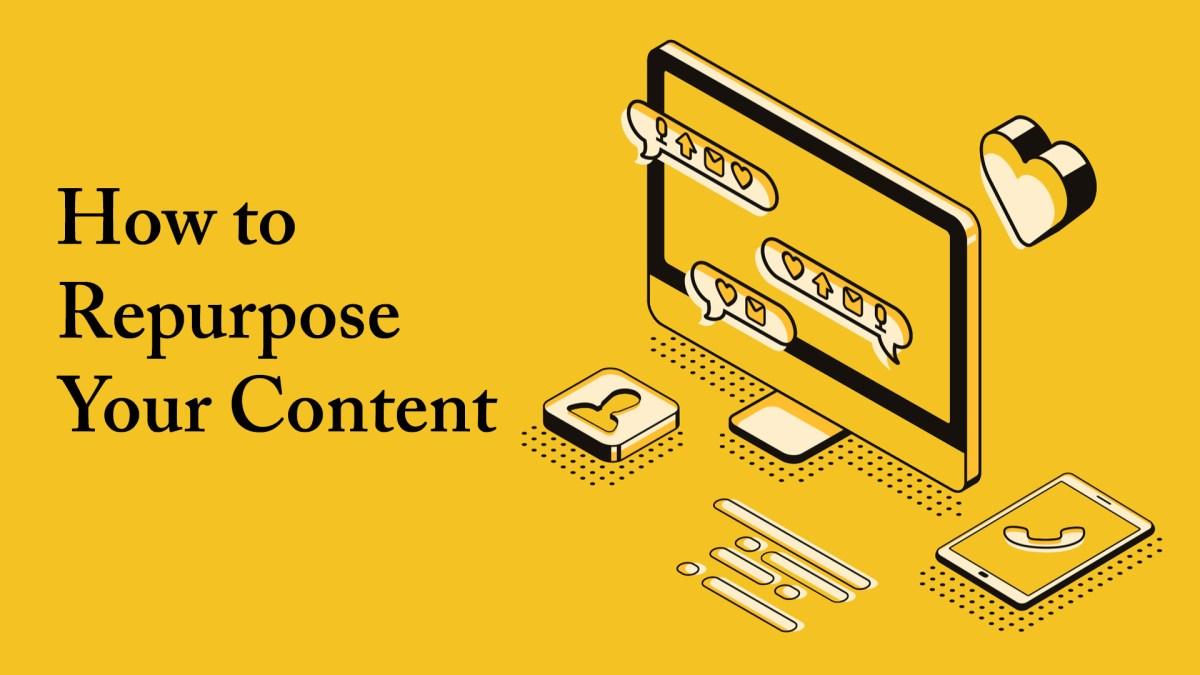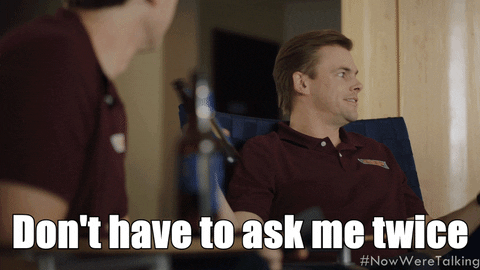
How to Repurpose Your Existing Content on Social Media
Wondering if we might be the right agency for your business? Schedule a call with us to learn more about our social media services and how we can help your business.
[Schedule Free Consultation]
Repurposing your content doesn’t just prevent your content team from losing their cool when you ask them for another 1,500-word blog post when the other one is sitting idly by in your Hootsuite queue. It also helps your audience see you across different platforms in various mediums. People respond to content in different ways; some folks respond better to audio content than long-form blogs, so why not repurpose your content to catch ‘em all?

Besides, don’t you desire the kind of clicks that will cause your marketing team to Kool-Aid man into a room when they see those MQL numbers spike?
The added SEO value by repurposing your content with SEO-focused tweaks is a great way to garner more traffic on different versions of your messaging. Aka putting more out there in a refined, SEO-friendly way can greatly help you with search engines and therefore bring more people into your site.
In the words of Salma Jafri, “create less, promote more.” Or as I might say, “create once and then facelift it often” or something like that. Let’s dive in.

1. Existing Blogs
Do you have a blog or multiple blogs that need a little cleanup? Well put your Property Brothers hat on and get to work. Taking an older blog post and giving it a fresh coat of paint will go a long way.

Do you have a blog post that’s heavy on metrics and data? Turn it into an infographic. Take that data and pop it into Canva to give it an update. Or if Google Slides is more your jam, use Slides to make a visually eye-catching graphic of the information from your blog. Focus on key numbers and icons to draw the reader in.

For example, let’s say you have a blog called Seven Takeaways from Working in XYZ Project Management Tool. Take those 7 blurbs and turn them into a graphic with short sentences and pops of color that match your brand.
Join over 1500 marketers on our newsletter!
What about long-form blogs? Turn those into compelling eBooks or guides that make sense for your buyer personas. Update the copy, add some charts, bring in customer quotes and turn it into a pdf that would be worth downloading. Don’t just place the blog on an InDesign template and hope for the best. Your website visitors deserve better. Make it stand out.

I once took a “Rethink Your PLM” blog post for Product Success Platform and turned it into a well-designed PDF with customer photos and pull quotes along with updated copy that made sense for the current market landscape. The hardest part of the whole process was finding the right cover photo from Unsplash. If I can do it for product lifecycle management, you can do it for your industry.
2. Existing eBooks
If you have existing eBooks now is a great time to give them a content refresh and update them with new titles. Consider this your opportunity to A/B test new titles. Perhaps you have an eBook called “The Complete Guide to SaaS Metrics” sitting in your file storage as we speak. Take that eBook and update the title to something a little spicier or something inline with your voice and tone. Try “2021 Guide to SaaS Metrics” or something more timely to the climate like “SaaS Metrics in a Remote World.” While yes it’s essentially the same content under the hood, you’re updating it with a new cover, new title, updated copy, and maybe even some new charts or images too.
Be sure to update the landing page you’re hosting the content on too. Make sure everything is buttoned up and not half put together.

If you don’t want to turn an eBook into yet another eBook you can grab snippets from it for social posts. Perhaps your eBook includes some fortune cookie knowledge that your audience would appreciate, in that case, put them on a well-designed social graphic that is in line with your branding and voice and tone and hit that schedule button.

3. Existing Demos and Webinars
If you’re a B2B SaaS company with a treasure trove of product demos burning a hole in your Vimeo or Wistia pocket here’s some food for thought. Consider splicing the demos into “teaser” videos for other parts of your website or prospecting emails. On your website, you can use them as content in the hero section of your product pages or you can slice and dice them into posts for LinkedIn with some engaging text and maybe even some b-roll from Envato or Storyblocks. Embrace your inner filmmaker.

Depending on your level of experience with video, you can use Adobe Spark, After Effects or even lesser-known tools like InVideo to give your demos a revamp. Cut the videos into sections that focus on key features with text that highlights the benefits of the platform, and don’t forget to include captions along the way. Storyboard your idea in Google Slides or on your Moleskine first then start cutting those existing demos into digestible chunks for your audience to enjoy on LinkedIn or Twitter. Make videos for each individual channel versus one for all. Each channel not only varies on the required specifications for uploads but each also have very different users on the receiving end. Again, don’t forget about those captions. Your content should be legible and understood without the audio and above all else, accessible for all users.
Once you’ve done a few of these videos consider making a version for your sales reps to use in prospecting. These videos can be used in email or pitch decks for top-of-funnel conversion. Similarly, they can be used to upsell features to existing customers. Your Customer Success team would love to utilize this kind of content instead of an outdated Zendesk article on feature ABC.
As for webinars, you can approach your existing ones the same way. Be sure to highlight customer quotes or key metrics that are pertinent to your audience. Utilize iconography and text in the videos so folks can understand it without the audio. You can even turn those webinars into guides or eBooks. Just make sure you update any metrics that have since changed and include great pull quotes from those in the webinar. And just like all content, be sure to make it accessible.

4. Existing Case Studies
This one might be the one collecting the most dust on your Google Drive shelf but it doesn’t have to be. Case studies are a lot of work and you want to make sure you get your money’s worth from on the clicks and content front. You can repurpose those lengthy PDFs in the same way you did everything else; infographics, social snippets, video teasers, and even blogs.
Take this case study I wrote for example. I interviewed the two folks from the company back in late 2019 and then published the video and written PDFs in April 2020 (the start of the pandemic pretty much slowed down the editing and publishing process but I digress). Since publishing it last April, we have since written many blogs and social media posts based on the content in that case study. Including takeaways from the customer, lessons learned on insert buzzword here, and more. The publishing of the case study doesn’t mean closing the door on the content within it. That is the most fruitful and trustworthy content you can write in the B2B world because it comes from the mouths of your actual users. The content possibilities from case studies are endless.

5. Existing Explainer Videos
Explainer videos can be repurposed in a few ways depending on your time and budget. You can cut them into smaller videos to highlight different parts of your product offering by utilizing scenes within them. Take this video from SiteSearch360 for example. You can use section 0:21-0:26 of the video to highlight a portion of the platform in a new and engaging way that isn’t a static screenshot on a Macbook screen. By grabbing content from explainer videos you open the door to content that can be looped for different platforms or use cases.

Another way to utilize that animated explainer video that’s sitting in your HubSpot file library is by grabbing high-resolution images of the characters within it for your website, slides or blog posts. You could turn them into mascots for your company if it makes sense on the branding front. Or you can create a blog series around the characters using your product.
For example, take this video from Pipedrive. They used animation to explain what their product does, aka they made an explainer video. If they wanted to they could take these characters and give them a blog series where they use them as characters who would use their product. Each blog post could highlight a different use case as portrayed by one of these characters.
6. Existing Podcasts
Your library of published podcast episodes is a treasure chest of content just waiting to be repurposed. If you haven’t already you can transcribe any interview-style podcasts into Q&A-style blog posts or turn them into Twitter threads for your audience. Be sure to add some relevant social graphics to your posts, again, only if it makes sense for your brand.
Similarly, depending on your content you could try turning any tips you have in the podcast into graphics for Pinterest. Let’s say you have a podcast episode where your founder explains how your company was founded and how it grew to where it is today. Turn those tips into a well-designed infographic and test drive it across different channels. You could even do one for different segments, like small businesses or Shopify stores. Make it make sense for your audience but with your own spin on it.

Podcast episodes can be turned into eBooks as well. Create a story from the episode or turn them into a guide of steps laid out in the episode. For example, take this episode from How I Built This where they talk to John Foley of Peloton. How I Built This could slice and dice this interview into audio snippets for social media, they could turn them into engaging graphics for Instagram or make a powerful set of slides for LinkedIn Slideshare. I’d be willing to bet they probably turn their vase library episodes into decks to use when pitching folks to be guests on their show. In the B2B world, you could do something similar and include content from your podcast episodes in investor decks, customer onboarding videos, Zendesk articles and more.
Because podcast episodes tend to be longer and usually more informal, you have a lot more runway to craft great content from them. You can take that informal conversation between your CEO and Engineering Lead into something really great, perhaps a blog post to highlight the strength of your platform and the team that built it? You could even take an episode around your customers and turn it into a webinar. Use the episode as a tease for a webinar as a way to drive sign-ups.

Time to Get to Repurposing
The opportunities with your existing content are endless. It’s up to you to figure out what makes sense for your brand, your bandwidth, and your company’s goals for the year.
You most likely have a lot of content sitting patiently waiting for you to repurpose it and contrary to popular belief it doesn’t have to be expensive or time-consuming. By utilizing existing content you’ve already done a lot of the heavy lifting so this is where the creativity gets to have some time on the stage. You know your audience and you know what did and didn’t work with the first piece. Take that data and bundle it with your creative juices to make some awesome content that will have your audience running for that like and subscribe button.

Repurposing content is a great opportunity to try something new, A/B test an idea you’ve been sitting on, or a way to test drive a new tool you’ve been waiting to try. The odds are in your favor here. You got this!
















